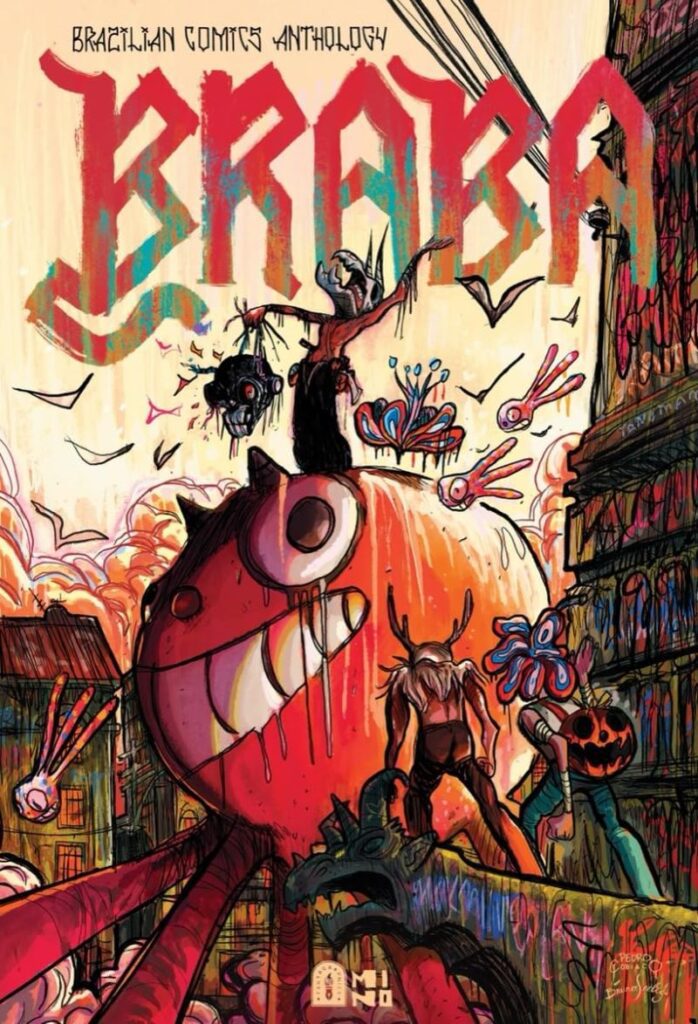
Fantagraphics ventures deep into South America with this new graphic novel anthology featuring short works by 16 Brazilian artists. The only unifying theme is the nationality of the artists, with no guidelines to craft Brazilian stories or stick to any specific genre. This results in a dizzying array of mostly intriguing comics, a fascinating glimpse of works from a market we normally wouldn’t be able to experience.
Buy Braba: A Brazilian Comics Anthology bookUnlike most anthologies that simply provide brief artist bios on a page or two at the end, this collection includes full-page introductions of the authors before each comic, further highlighted by exclusive artwork by Pedro Cobiaco for each introduction. He also provided the lively cover art, a fitting teaser of the unfettered artistic wonders within the book. The book is curated and introduced by noted Brazilian cartoonist Rafael Grampá (Batman: Gargoyle of Gotham), providing some U.S. mainstream cred to his countrymen.
Amanda Miranda’s opening short is defiantly original, lurid in both theme and coloring with its intense colors and graffiti-esque abandon. The story seems to be striving to make some commentary about cyber pitfalls but doesn’t make much sense.
Bruno Selig’s delightfully exaggerated and kinetic characters make him a prime candidate for future YA comics, but again the story fails to gel.
Diego Sanchez brings a drawing style that is reminiscent of European comics and Brandon Graham, with impressive panel variety stuffed with his inviting black-and-white linework.
Gabriel Goes presents of series of arresting full-page black-and-white (and eventually red) images, heavily toned in a manner that makes them appear like zoomed-in old-school TV stills or lo-res jpegs, but no discernible story emerges.
Jefferson Costa’s loose, evocative character rendering exhibits expert shading to add weight to his creations. Its dull palette and wisp of a story about gutter punks in the present and a warrior queen and her leopard in the past fails to reach any meaningful connection or resolution.
Young artist Jessica Groke shows promise in her creative page layouts, ink washes, and wordless story that moves from the suburban drudgery of new motherhood to jungle mysticism. However, her figure rendering is not quite ready for primetime, still in search of a cohesive aesthetic.
Joao Pinheiro and Sirlene Barbosa’s short presents black-and-white linework that is a bit tighter than Groke’s, but the story sets up a grim scenario of domestic abuse without any glimmer of plot development or conclusion.
Paulo Crumbim and Cristina Eiko lean hard on Eiko’s Japanese heritage, with her manga-inspired work displaying the most conventionally appealing and kawaii graphic design. Also, it’s the most accessible and humorous story, as a couple playfully bicker about proper spaghetti preparation over dinner.
Pedro Cobiaco didn’t just render the cover and introductions; he also presents one of the book’s best works. His story is the closest in both his exuberant loose brushwork and lyrical, insightful writing style to Brazil’s most famous comics exports, twin brothers Fabio Moon and Gabriel Ba (Daytripper). It’s a masterful piece anchored in the grim reality of a hardscrabble life yearning for happier days gone by.
Pedro Franz is so experimental that he needs to go back to the lab, presenting a series of crudely rendered, elementary-level pencil images seemingly starring Tintin while a bizarre and wholly unrelated monologue scrolls by.
Rafael Coutinho presents the longest and most fully realized piece, telling a story about a vampire who wakes up to great confusion during the pandemic. Vibrant lines and coloring enhance the solid tale.
Shiko has a super-clean style with polished lines and watercolors, as well as a complete story about a humble doorman stuck between a loveless marriage and a samba dancer carrying his child.
Wagner Willian recounts a lushly illustrated story of a minotaur in ancient Greece, trying but failing in its final image to juxtapose his struggle with the plight of indigenous Brazilians versus colonizers.
Braba succeeds in its quest to introduce lesser-known Brazilian cartoonists to the U.S. market. As with all anthologies, readers will have clear favorites from the collected works, which ideally will inspire them to follow the careers of those creators. For me, the creators I’m adding to my fanboy list are Pedro Cobiaco, Diego Sanchez, Cristina Eiko, and my top pick, Shiko, but I was impressed by the artwork of most of the pieces. While I wish the comics had some narrative heft and were at least a bit more thematically Brazilian, it is refreshing that the creators chose to explore comics as a universal language with nary a glimpse of Rio-centric touchstones such as Carnival, Copacabana Beach, or favelas anywhere in sight.